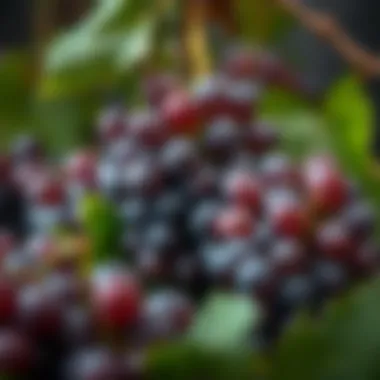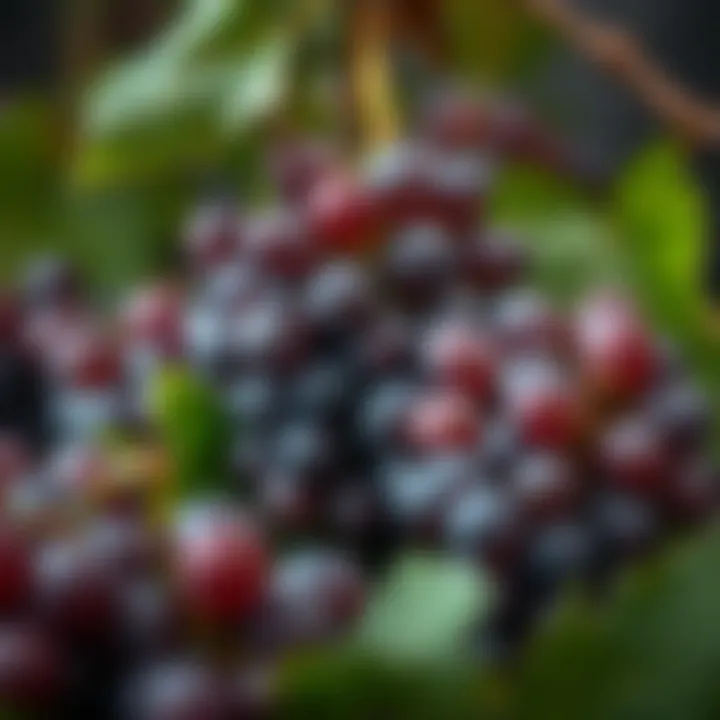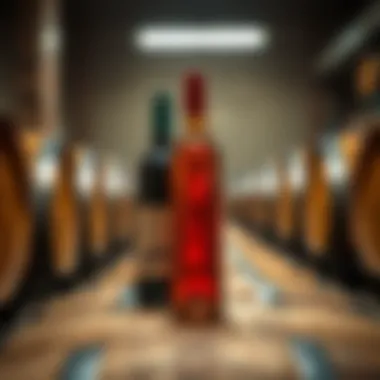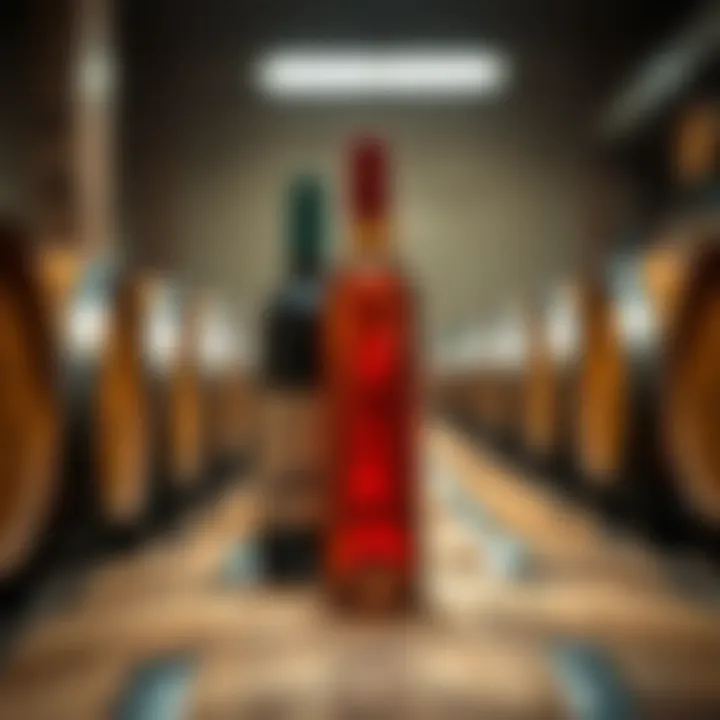Exploring Low-Sugar Wines: A Comprehensive Guide


Intro
In the current landscape of modern winemaking, an increasing number of consumers are gravitating toward health-conscious options. While indulging in a glass of wine remains a cherished ritual, the focus on lower sugar content reflects a broader trend toward wellness that resonates with many drinkers. This evolution does not merely stop at dietary choices; it represents a shift in mindset where quality, flavor, and health coexist.
Low-sugar wines have carved out their own niche, with many wine aficionados keen to explore this category. These wines are produced with the intention of minimizing residual sugar, which can offer a more balanced drinking experience. The intricacies involved in crafting these wines often hinge on various factors including fermentation processes, grape selection, and even regional terroir.
What defines a low-sugar wine? Generally, wines with less than 1 gram of sugar per liter are considered low-sugar. This delicate balance between sweetness and acidity intrigues both established wine lovers and newcomers alike who are navigating the vast vineyard of choices.
As we delve into this comprehensive guide, the intention is to illuminate the very fabric of low-sugar wines. From understanding how they are made to identifying specific varieties that fit the bill, this exploration will equip you with knowledge to make informed selections. Not only is the scientific aspect of winemaking fascinating, but it also arms you with the information needed to elevate your wine experiences, whether you are toasting a special occasion or simply enjoying a quiet evening.
By unpacking the key elements that contribute to the sugar levels in wine, as well as examining the production methods employed by various winemakers, readers can gain insights into selecting wines that align with their personal and health preferences. Let's begin this journey into the realm of low-sugar wines, uncovering the stories, characteristics, and choices that define them.
Understanding Sugar in Wine
Sugar plays a pivotal role in the world of wine, weaving its presence through the fermentation process and influencing the final taste of each bottle. Knowing about sugar in wine is essential for enthusiasts who want to make informed choices, particularly when opting for low-sugar varieties. It's not just a matter of preference; it has significant implications for health, flavor, and overall enjoyment. Here, we will dissect the fundamental concepts surrounding sugar content in wine, setting the stage for a richer understanding of your next bottle.
The Basics of Sugar Content
To appreciate wine fully, one must first grasp the concept of sugar content. When talking about wine, sugar is primarily derived from the grapes used in the fermentation process. Each grape variety carries its unique sugar load, which can dramatically affect the characteristics of the wine produced. For instance, sweeter wines like Moscato typically possess more residual sugar, while dryer options such as Chardonnay or Sauvignon Blanc have much less. Understanding these variances is crucial when selecting a low-sugar wine.
Moreover, residual sugar is often a point of contention. This term refers to the sugar leftover after fermentation—basically, what lingers after the yeast has done its thing. A wine labeled as dry may still contain some sugar, just at a lesser quantity compared to sweeter counterparts. Thus, it helps to examine the specific sugar content listed on the label to truly know what you’re pouring into your glass.
Fermentation Process and Sugar Levels
The fermentation process is where the magic—and chemistry—happens. Initially, grapes are crushed to release their juice, which is loaded with sugar. Yeast is then introduced, transforming that sugar into alcohol. The crucial part to understand is how this process varies depending on a few factors, such as grape type, fermentation temperature, and even winemaker practices.
- Grape Varieties: Some grape types naturally hold more sugar, leading to a more significant conversion during fermentation. Varieties like Zinfandel offer higher sugar content, affecting the wine’s sweetness and flavor complexity.
- Temperature Control: The temperature during fermentation can also play a role in sugar retention. Cooler temperatures tend to slow down yeast activity, allowing more sugar to remain after fermentation, possibly producing a sweeter wine.
- Winemaking Practices: Techniques such as stopping fermentation early can create wines with higher sugar content. Conversely, allowing fermentation to run its full course will result in a drier product with minimal residual sugar. Winemakers often have to make strategic decisions depending on the desired outcome for the wine.
The fermentation process isn’t just an over-and-done scenario—it’s an intricate dance of timing and choices that can lead to vastly different results. This knowledge becomes critical when navigating through wine selections, especially low-sugar options. As consumers, understanding these elements can considerably enhance your wine tasting experience, guiding you toward the products that best fit your taste—and health—preferences.
Types of Low-Sugar Wines
Understanding the various types of low-sugar wines is critical for anyone looking to modify their drinking habits without sacrificing pleasure. The nuances of these wines can enhance both the dining experience and overall health. In a market flooded with sugary options, knowing what to look for in low-sugar varietals enables consumers to make informed choices. Furthermore, exploring different types of low-sugar wines unveils unique flavors and aromas that can enhance one’s wine journey.
Dry Wines: The Sugar Spectrum
When we talk about dry wines, it’s like entering a world where sweetness takes a back seat to acidity and tannins. These wines generally contain less than 1% sugar, allowing the true essence of the grape to shine through. Dry red wines such as Cabernet Sauvignon or Pinot Noir offer robust flavor profiles that can be savored without the clingy sweetness often associated with sweeter varieties.
But it’s not just reds that excel; dry white wines like Sauvignon Blanc and Chardonnay are equally worth a shout. They often have crisp acidity that not only cuts through richness on the plate but also elevates a simple seafood dish to a new level.
Opting for these dry wines can benefit those who are conscious of sugar intake but still want to enjoy a glass at the end of the day. The complexity found in a well-crafted dry wine can easily make it the star of your table.


Sparkling Wines with Reduced Sugar
Ever had a glass of bubbly that didn’t leave your palate feeling sticky? That’s the beauty of sparkling wines with reduced sugar. Many traditional sparkling wines contain quite a bit of sugar, especially those labeled "Doux" or "Demi-Sec." However, there are options like brut nature or extra brut that feature minimal sugar content, often clocking in at less than 3 grams per liter.
These sparkling wines can be delightfully refreshing, complementing a warm summer afternoon or a special celebration without excessive sweetness. The fizz enhances the experience, providing a contrast to savory dishes or a light salad. A brut nature Champagne or a sparkling Sauvignon Blanc might just become your best friend when the warm sun calls for a chilled glass.
Fortified Wines: A Closer Look
Now, fortified wines tend to confuse many given their sometimes higher sugar content; however, there are ways to enjoy them in moderation. Sherry and Port wines offer rich flavors and complexity, with certain styles being naturally lower in sugar. For instance, a Fino Sherry has a dry, nutty quality with less residual sugar compared to its sweeter counterparts, which often have a syrupy character.
The beauty of fortified wines lies in their versatility. While they might not be the first choice someone would consider when looking for low-sugar options, a little perusal can yield exciting finds. Pairing these wines with cheese or dark chocolate not only highlights their strengths but may also keep sugar levels in check—allowing you to indulge while still being mindful of your choices.
Factors Affecting Sugar Content in Wines
Understanding the factors that influence sugar content in wines is pivotal for anyone keen on low-sugar options. It’s vital as it not only shapes the final product but also determines the health implications associated with wine consumption. Each factor contributes significantly, inviting a range of flavors, aromas, and sweetness levels. By grasping these aspects, the wine enthusiast can make informed choices, aligning their selection with personal taste and health preferences.
Grapes Varietals and Their Influence
The varietal of grapes used in winemaking plays a crucial role in the sugar profile of wine. Each grape has its own unique characteristics regarding sweetness and acidity. Let’s consider a few examples:
- Chardonnay is primarily known for its crisp, dry flavor with a lower sugar content. This grape variety retains acidity, balancing the tartness with minimal sweetness.
- Riesling, on the other hand, can be a double-edged sword; it can produce both sweet and dry wines. The key lies in the ripeness of the grapes at harvest. Late-harvest Rieslings, for instance, can lead to higher residual sugar levels.
Moreover, not all grapes ferment the same way. Some varieties are more resilient and can balance the sugar content better through fermentation. Consequently, understanding the origin and variety of grapes is a fundamental cornerstone when selecting low-sugar wines.
"The variety of grapes chosen can make or break the low-sugar promise of any wine."
Winemaking Techniques that Minimize Sugar
The pathway to achieving a low-sugar wine is not just in the choice of grapes; it’s also embedded in winemaking techniques. Several methods can restrict sugar levels during production:
- Fermentation Control: This is the key. Winemakers can tweak fermentation times and temperatures to ensure that more sugar is transformed into alcohol. A swift fermentation at cooler temperatures often keeps the sugar levels down.
- Malolactic Fermentation: This technique is often employed in red wines. It converts sharper malic acid into softer lactic acid, resulting in smoother flavors with less apparent sweetness.
- Filtration and Adjustments: Certain filtration processes can remove residual sugars, producing a cleaner finish. Adjusting the must (the freshly pressed juice) prior to fermentation can also help minimize sugar.
Understanding these methods provides insight into how wines can be crafted to maintain lower sugar content while still offering complexity in taste.
Climate and Terroir Impacting Sugar Levels
The climate and terroir in which grapes are cultivated greatly influence sugar accumulation. Grapes absorb nutrients and moisture from the soil, which can ultimately affect their sweetness.
- Warmer Climates: Grapes grown in sun-soaked areas often accumulate more sugar. For instance, grapes from California's Napa Valley can yield fruitier wines with higher sugar levels than those from cooler climates.
- Soil Composition: Different soils impart various characteristics to the grapes. Soils rich in nutrients might lead to faster ripening, elevating the sugar levels in the fruit. Clay-heavy soils tend to retain moisture, nurturing deeper roots and potentially sweeter fruit.
- Microclimates and Elevation: These play a nuanced role. Grapes grown at higher altitudes may experience cooler temperatures, which help preserve acidity while keeping sugar levels more moderate.
In essence, the interplay between climate and soil sets the stage for the winemaking journey. An appreciation for these factors not only enriches one’s understanding of low-sugar wines but also highlights the artistry behind wine production.
By keeping these elements in mind, anyone venturing into the world of low-sugar wines can not only relish the tasting experience but also encourage a mindful approach to wine selection. To delve deeper into these topics, notable resources include Britannica, Wikipedia, and other educational sites.


Health Considerations of Low-Sugar Wines
When discussing low-sugar wines, it’s crucial to consider the broader health implications that come with them. As our diets increasingly adapt to focus on wellness, the type of wine we choose plays a role in that journey. This section digs deeper into how low-sugar wines can fit into various dietary choices, highlight the potential health benefits, and provide a comprehensive view of the interplay between alcohol and sugar.
Low-Sugar Wines and Dietary Choices
Choosing low-sugar wines aligns with many modern dietary trends. As more people turn to specific eating plans, like keto or paleo, being mindful of sugar intake remains paramount. Low-sugar wines generally contain fewer than 1% sugar, making them suitable for those who are cautious about their carbohydrate consumption.
Some key points to consider:
- Compatibility with Diets: Low-sugar wines can complement diets that restrict sugar, like those recommended for diabetics. While moderation is important, these wines may offer an alternative for those who enjoy wine without the subsequent sugar spikes.
- Versatility in Food Pairing: The lower sugar content often allows for a more nuanced pairing with food. Steer clear of dominating sweetness in wine, allowing the flavors of both the dish and the wine to shine.
- Sustainability: Many low-sugar wines are also produced by organic or sustainable means, appealing to environmental-conscious consumers.
Thus, keeping an eye on the sugar content in wines not only helps maintain a balanced diet, but it also aligns personal health goals with lifestyle choices.
Potential Health Benefits of Reduced Sugar Consumption
There’s a growing body of evidence that outlines the benefits of consuming less sugar. When it comes to wine, opting for a low-sugar version can lead to several potential health advantages. Here are a few noteworthy benefits:
- Weight Management: Reducing sugar intake helps with weight control, as sugar contributes extra calories with little nutritional benefit. Low-sugar wines are lower in calories, making them a smarter choice for those looking to shed a few pounds.
- Reduced Risk of Chronic Disease: High sugar consumption has been linked with numerous chronic diseases, including heart disease and diabetes. Lowering sugar intake, through options like low-sugar wines, can reduce these risks and promote long-term health.
- Improved Energy Levels: By avoiding the sugar crashes that can follow high sugar consumption, individuals may experience steadier energy levels. Wine with less sugar means fewer sugar-induced highs and lows, contributing to a more consistent energy supply throughout the day.
"Wine in moderation doesn’t have to be a guilty pleasure; choosing low-sugar options can balance enjoyment with a healthy lifestyle."
Alcohol and Sugar: An Overarching Perspective
Though it’s tempting to think of low-sugar wines simply as healthier options, it’s essential to understand the relationship between sugar and alcohol on a broader scale. Alcohol itself can affect body metabolism in various ways. Some perspectives to keep in mind include:
- Metabolism Factors: The body processes sugar and alcohol using the liver. Both substances can create extra work for the liver, but wines that are low in sugar allow for a more manageable process, potentially leading to fewer negative effects.
- Social Considerations: Enjoying alcohol in moderation is generally accepted within many cultures. However, being aware of one’s alcohol and sugar intake is increasingly viewed in the context of promoting a healthier drinking culture.
- Finding Balance: The key takeaway is balance; recognizing the implications of both alcohol consumption and sugar intake is vital for well-being. Choosing low-sugar wine enables relaxation and enjoyment without the guilt associated with sugar-laden options.
In summary, the thoughtful engagement with low-sugar wines offers a pathway towards healthier dining practices while still preserving the pleasure of enjoying a glass of wine. By understanding these health considerations, drinkers can make informed choices that resonate well with their lifestyle.
Selecting Low-Sugar Wines: A Guide
When it comes to selecting low-sugar wines, having a solid understanding of what to look for can greatly enhance your wine drinking experience. This process isn't just about picking a bottle off the shelf; it involves awareness of various factors that contribute to sugar content, labels, and ultimately the quality of the wine. In today’s health-conscious society, many consumers are turning to wines with reduced sugar content, believing they provide a more authentic tasting experience while aligning with healthier dietary choices.
Reading Labels and Wine Scoring
Understanding wine labels can feel like attempting to decipher hieroglyphics for some, but it doesn't have to be a daunting task. Wine labels often include vital information about sugar content, typically expressed in grams per liter. A low-sugar wine usually has less than 3 grams of sugar per liter, though this can differ based on regional regulations and winemaking practices.
To navigate these labels effectively:
- Check the residual sugar (RS): Many winemakers will disclose this figure. If the label mentions ‘dry’, it typically indicates lower sugar levels. However, ‘dry’ doesn’t always mean ‘no sugar’.
- Look for terms like “brut” or “extra brut”: This is especially relevant for sparkling wines, which generally contain less sugar.
- Consider the region: Different wine-producing areas have varying standards. For example, wines from cooler climates often display lower sugar levels due to the shorter growing season.
"The label is your roadmap; understanding it is key to finding the best low-sugar wines for your palate."


Many consumers now rely on wine scoring systems, which evaluate wines on a scale, often taking into account factors such as flavor profile and sugar content. Appraisal from certified wine reviewers can also serve as a helpful guide, but remember preferences can vary greatly among individuals.
Recommendations for Authentic Low-Sugar Wines
Finding authentic low-sugar wines can be somewhat of a treasure hunt. Fortunately, several options are well-regarded in the wine community for their naturally low sugar content:
- Sauvignon Blanc: This white wine is crisp and vibrant, boasting lively acidity that often compensates for its minimal sugar content.
- Pinot Noir: As a lighter red, Pinot Noir balances fruitiness with earthy undertones, and it generally falls into the low-sugar category, especially when produced in drier climates.
- Prosecco (brut): A dry sparkling wine that can be a delightful option, perfect for celebrations or casual sipping while keeping sugar levels in check.
- Chablis: A type of Chardonnay from the Burgundy region that is often fermented without any residual sugar, yielding a mineral and refreshing wine.
In addition, many wine producers now specify "no added sugar" on their labels, giving you peace of mind in your purchase. Turning to smaller, boutique wineries can also yield exciting finds, as many prioritize traditional, lower-sugar winemaking methods.
As you delve into the world of low-sugar wines, the process will become clearer and arguably much more enjoyable. With a touch of knowledge about reading labels and knowing which wines are more likely to meet your sugar criteria, you’ll be well on your way to making more informed decisions.
Trends in Low-Sugar Wine Consumption
The popularity of low-sugar wines has seen a marked rise in recent years, reflecting a broader trend toward health-conscious drinking habits. With an increasing number of consumers becoming aware of sugar's health implications, many are reassessing their beverage choices. This transformation is not merely a passing fad; it signifies a shift in how people engage with wine. Today, more than ever, wine enthusiasts and the casual drinker alike are searching for options that align with their lifestyle choices while still providing an enjoyable experience.
The Shift toward Health-Conscious Drinking
In our current society, health is an ever-present topic. People are looking beyond just calorie counts; they're diving deeper into ingredient lists, scrutinizing not only what's there but what's absent. Low-sugar wines fit neatly into this narrative. Many consumers are substituting traditional choices for options that leave less sugar on the table.
- Lifestyle Changes: With fitness trends and nutritional information at our fingertips, folks are adopting diets that often place emphasis on lower sugar intake. Whether it's through social media, food blogs, or documentaries, information flows freely and is influencing purchase decisions.
- Health Benefits: Research points toward benefits associated with lower sugar consumption, including reduced risk of various health issues such as diabetes and obesity. As people become aware of these potential advantages, low-sugar wine becomes more appealing.
- Mindful Drinking: The concept of mindful drinking is on the rise. Many are eager to enjoy their favorite wine with a clear conscience, and low-sugar options allow for indulgence without guilt.
"The surge in health-conscious products reflects a societal shift, prioritizing ingredients and nutritional content," says a well-respected industry expert.
Consumer Preferences and Market Demand
The demand for low-sugar wines is changing the landscape of the beverage industry. This shift is characterized by several notable trends:
- Increased Availability: Wineries and manufacturers are beginning to respond to consumer preferences, resulting in an uptick in the availability of low-sugar wines in the market. As consumer demand grows, the industry is adjusting to meet this new standard.
- Diverse Selection: No longer confined to just a handful of options, the selection of low-sugar wines is expanding rapidly. From reds to whites and sparkling varieties, drinkers have fun exploring a wide range of flavors without the sweet aftertaste.
- Demographic Growth: Interestingly, trends show that younger generations are notably interested in low-sugar offerings. Millennials and Gen Z are particularly focused on healthier lifestyles and, in turn, their wine choices reflect this.
As the market continues to evolve, industries often follow suit, adapting to shifting consumer needs. Low-sugar wines are here to stay, and it will be fascinating to watch how they evolve as even more people prioritize their health while enjoying their favorite wines.
Finale: The Future of Low-Sugar Wines
As the conversation around health and nutrition evolves, the role of low-sugar wines has become increasingly prominent in both casual dining and sophisticated culinary experiences. This article has illuminated the multifaceted aspects of low-sugar wines and their production, characteristics, and health implications, converging to a significant conclusion: the future of low-sugar wines is not just a trend; it's a reflection of a wider cultural shift towards mindful consumption.
One major driving force behind the rising interest in low-sugar wines is the growing awareness of dietary choices. Wine enthusiasts are becoming more discerning. They are actively seeking out options that align with their health goals, yet still provide the pleasure and complexity of flavor they anticipate from a fine bottle. Low-sugar wines cater to this need by offering a viable alternative without compromising on taste.
The benefits of incorporating low-sugar wines extend into various realms including:
- Flavors: With reduced sugar levels, many low-sugar wines exhibit enhanced acidity and more defined fruit characteristics, creating a burst of flavors that can be extraordinarily vivid and enjoyable.
- Health Advantages: Lower sugar consumption is often linked to a myriad of health benefits, from reduced risk of obesity to better metabolic conditions. By offering low-sugar options, wineries are not just responding to a market demand; they're participating in promoting better health.
- Sustainability: Many vineyards that produce low-sugar wines adopt sustainable practices. They often focus on organic vineyard management and eco-friendly production techniques, aligning themselves with the values of environmentally-minded consumers.
As we ponder the landscape of wine consumption in the coming years, it becomes clear that innovation will play a pivotal role. Wineries may experiment more with varietals, fermentation processes, and expressions of terroir that embrace lower sugar thresholds. Such experimentation could very well redefine traditional concepts around wine making, making space for new flavors and styles that cater to diverse palates.
Furthermore, the intersection of technology and winemaking is likely to yield fascinating results. From precision viticulture to advanced fermentation monitoring, tech innovations could allow winemakers to gain more control over sugar levels, resulting in even more exquisite low-sugar wines that capture the hearts of the modern consumer.
“Wine is sunlight, held together by water.” – Galileo
For more information about low-sugar wines and wine production practices, check out resources on Wikipedia, Britannica, and discussions on Reddit.







